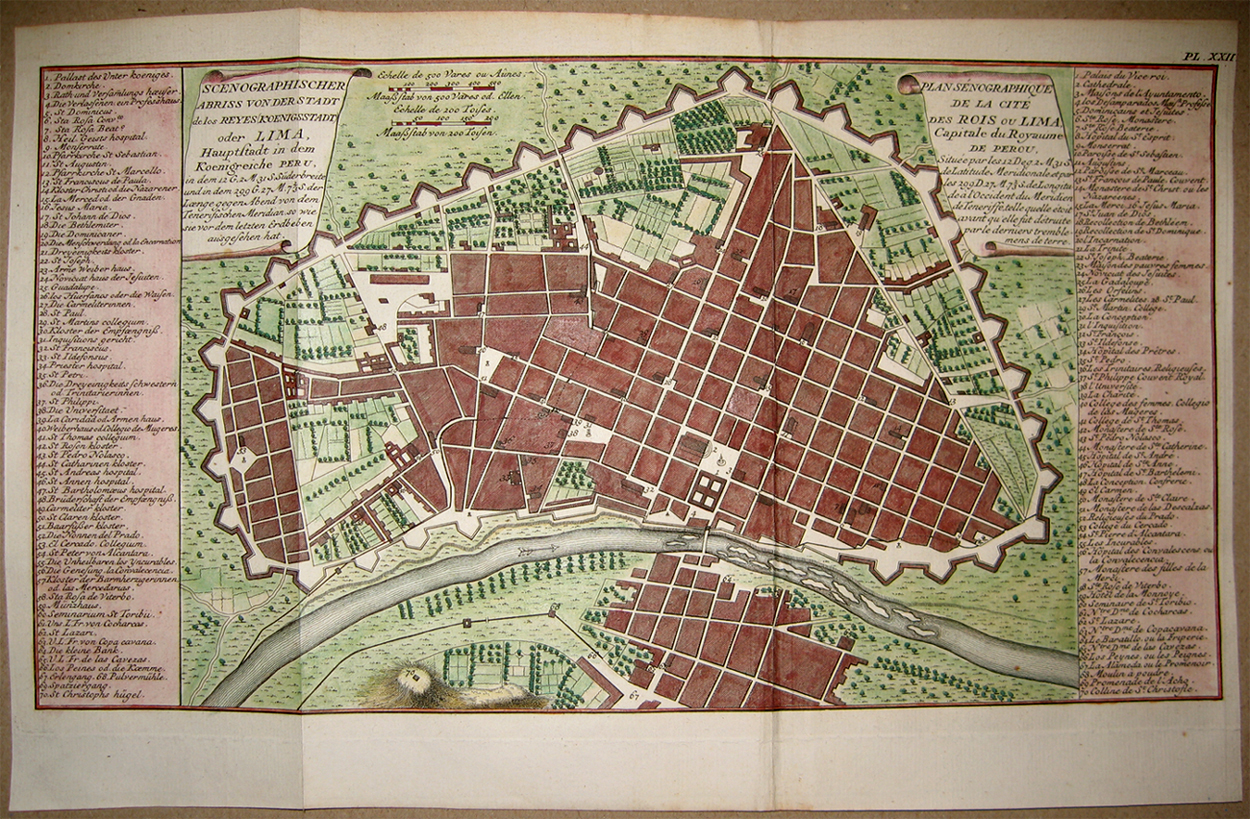Walls Of Lima on:
[Wikipedia]
[Google]
[Amazon]


 The Walls of Lima were a fortification consisting mainly of
The Walls of Lima were a fortification consisting mainly of wall-of-lime-santa-lucia Marco Gamarra (2010). "The last wall of Lima: Santa Lucía", '' The Marquense Library ''
/ref>

 The Walls of Lima were a fortification consisting mainly of
The Walls of Lima were a fortification consisting mainly of wall
A wall is a structure and a surface that defines an area; carries a load; provides security, shelter, or soundproofing; or, is decorative. There are many kinds of walls, including:
* Walls in buildings that form a fundamental part of the sup ...
s and bastions whose purpose was to defend the city of Lima
Lima ( ; ), originally founded as Ciudad de Los Reyes (City of The Kings) is the capital and the largest city of Peru. It is located in the valleys of the Chillón, Rímac and Lurín Rivers, in the desert zone of the central coastal part of ...
from exterior attacks. It was built between 1684 and 1687, during the Viceroy
A viceroy () is an official who reigns over a polity in the name of and as the representative of the monarch of the territory. The term derives from the Latin prefix ''vice-'', meaning "in the place of" and the French word ''roy'', meaning " ...
Melchor de Navarra y Rocafull (Duke of Palata)'s government.
The wall was located on the present streets of Alfonso Ugarte
Alfonso Ugarte (July 13, 1847 – June 7, 1880) was a Peruvian civilian turned military commander during the War of the Pacific, between Peru and Bolivia against Chile. He held the rank of colonel.
Ugarte was born in Tarapacá Province (Peru), ...
, Paseo Colón and Grau and the left bank of Rímac River
The Rímac River is located in western Peru and is the most important source of potable water for the Lima and Callao Metropolitan Area.
The river is part of the Pacific watershed and has a length of 204 km. The river begins in the highlan ...
. Under Luis Castaneda Lossio's management, he recovered a section of the remains of the left bank of the Rímac River, which are now visible as a part of the group known as "Parque de la Muralla," although these are probably from a previous construction known as "Tajamar de San Francisco." The Santa Lucía bastion is a sector of the wall located on the edge of Barrios Altos and El Agustino that still stands ./ref>
History
The old wall was built around the city to protect it from pirates attacks and other enemies of the Spanish crown in the 17th century. The wall had 10 exit and entry gates: Martinete, Maravillas, Barbones, Cocharcas, Santa Catalina, Guadalupe, Juan Simón, San Jacinto, Callao, Monserrate and the gate of la Guía en el Barrio de San Lázaro (now theRímac district
Rímac is a district in the Lima Province, Peru. It lies directly to the north of downtown Lima, to which it is connected by six bridges over the Rímac River. The district also borders the Independencia, San Martín de Porres, and San Juan de ...
).
As part of urban expansion programs and construction of new avenues, the wall was demolished in 1868 under José Balta's government. The wall never served the purpose for which it was built, to the point that Raúl Porras Barrenechea mentioned that "it died a virgin of gunpowder."
Current status
Part of the sea wall has been restored at the back of the Church of San Francisco, near the Government Palace, which has created a public space named ''Parque de la Muralla'' (The Wall Park). In this park, the remnants of the foundations that had been the seawall are visible, which was done by the Franciscans in 1610. The aforementioned park has a restaurant and a shop selling hand-made items from different areas of the country. The park contains a statue ofFrancisco Pizarro
Francisco Pizarro González, Marquess of the Atabillos (; ; – 26 June 1541) was a Spanish conquistador, best known for his expeditions that led to the Spanish conquest of Peru.
Born in Trujillo, Spain to a poor family, Pizarro chose ...
, which used to be in the "Plaza Perú," located next to the Government Palace. There is also a museum exhibiting archaeological pieces found in the area.
Construction of an expressway on Grau Avenue uncovered some of the wall's remains.
In Barrios Altos, the remains of the walls near the Plazuela del Cercado is in good condition. The camal de Conchucos, which was the bastion of Santa Lucía, one of the surveillance points of the wall, is now a sports complex.
The wall was not a paragon of beauty. Except for the portals of Maravillas (1807) in the Barrios Altos and El Callao, the other gates, as told by the painter Juan Manuel Ugarte, "had no great artistic appeal. It is one of the most important tourist attractions, besides the houses, among others.
See also
* Wall of Trujillo * Defensive wallNotes
Bibliography
* * {{coord missing, Peru City walls in Peru Buildings and structures completed in 1687 Colonial Peru Buildings and structures in Lima Tourist attractions in Lima Spanish Colonial architecture in Peru 1687 establishments in the Spanish Empire Demolished buildings and structures in Peru